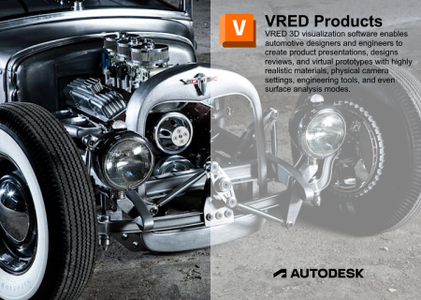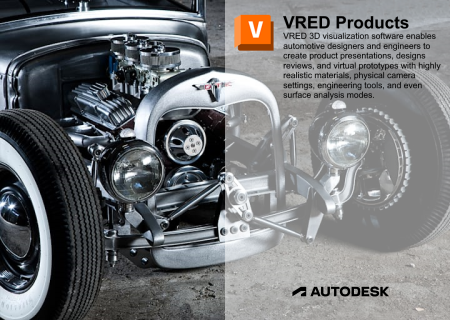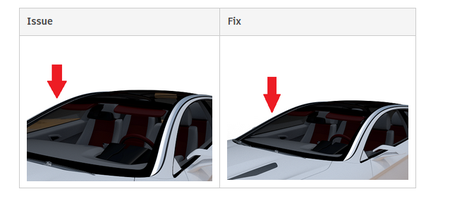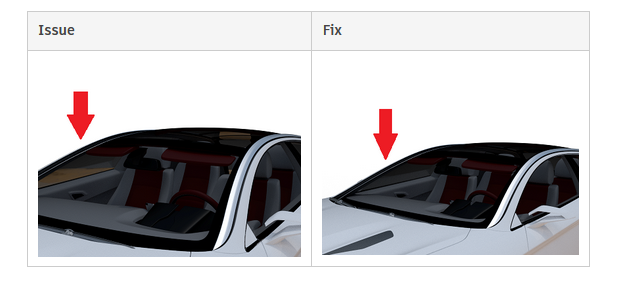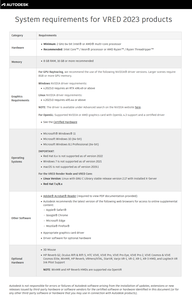Autodesk VRED Pro 2023.2 with Assets | 9.7 Gb
Autodesk Inc. is pleased to announce the availability of VRED Products 2023.2.0 is an visualization software enables automotive designers and engineers to create product presentations, design reviews, and virtual prototypes with highly realistic materials, physical camera settings, engineering tools, and even surface analysis modes.
What’s new in VRED 2023.2.0
Transparency Modes
We added Depth Peeling for order-independent transparency and per-pixel correct blending of transparent surfaces, without sorting. Render images with complex intersecting transparent objects, such as a headlight, with pixel-perfect accuracy. Under Visualization > Advanced OpenGL Settings > Transparency Mode > Depth Peeling you can toggle between Object Sorting (using the Sort Key of the material) and Depth Peeling. Use the Transparency Settings in Visualization > Advanced OpenGL Settings > Transparency Mode to set the depth of the peeling.
Camera Editor Decoupling
The decoupling of the Camera Editor is complete, making it possible to access all properties via the Python API. Menus and quick access icons have been added, making it easier to locate options and access frequently used tools. Use the search, filtering, and collapse/expand controls to locate cameras and viewpoints in the Tree List. Split the Tree List into two views for easier sorting/grouping. Improved the loading and saving of tracks and viewpoints. Also, when working with tracks, the number of tracks selected in the Tree List determines the number of tracks displayed in the Track View. And lastly, properties can now be changed on multi-selection for cameras and viewpoints.
Face-normal Rendering
Improved face-normal rendering, by adding two new colors to show invalid normals. These help you detect files that are broken and can only be repaired by recalculating the normals. Red normals are NaN or have a zero length, which creates NaNs when normalized. Pink normals have an absolute angle between the face and vertex normal above a threshold, such as 85°. Invalid Normals Valid Normals
Roughness for Clearcoat
Added a Roughness option to the Metallic Carpaint Clearcoat section for imitating clearcoat spray paint high-gloss satin and matte finishes in OpenGL, CPU raytracing, and GPU raytracing. Now, you can control the roughness, thickness, and density of the clearcoat for most materials, such as Plastic, Brushed Metal, Metallic Carpaint, and Carbon (2D/3D).
Denoiser Improvements
We added the choice of NVIDIA's OptiX GPU or Intel's Open Image CPU denoiser when rendering and for lightmap baking. Set this in the UI or with Python. Use setDenoiserModel for switching to the AOV OptiX Denoiser, instead of using the default HDR OptiX Denoiser for raytracing. It is possible to combine GPU raytracing with CPU denoising and vice-versa. Therefore, CPU raytracing with CPU denoising is now possible, if you don't have compatible RTX GPUs.
Disable Shadow Map Updates
We added setShadowMapUpdates(bool) and getShadowMapUpdates(). To prevent any shadow maps from updating, use setShadowMapUpdates(false). Lights created while the update is set to false will also be included and their shadow maps will not update. Re-enabling updates will trigger a render, updating all shadow maps.
Resolved FBX Textures Paths
We added support to resolve textures paths from FBX that are absolute to relative. This enables you to load textures with the file, without the need for manually reloading each texture.
Improved Photometric Dialog
Added a checkbox and removed a button from the Enable Photometric Parameters dialog to make it easier to choose the correct option for activating/deactivating the photometric mode and, therefore, reduce rendering issues.
Help Changes
For Python, we renamed the Python API V1 commands in the TOC for easier searchability and added example links to classes that have Python example files. For logo text and projecting textures, we added the Working with Logos and Projecting Textures topic at the request of a user. There are simple instructions for mapping a logo onto a material, adjusting its placement, and adding a bump map. We've also included information on dragging and dropping a texture from outside of VRED directly onto geometry in VRED and creating a decal from there. Lastly, find links to additional information, including a video on Texture Projection Settings. For the Material Editor, find all common attributes now only in General Truelight Material Settings. Content unique to a specific material is found in that material, along with links to common attribute information.
These are the issues we fixed in VRED 2023.2 products:
Animation
- Camera Position Changes - Output animation for constrained cameras no longer jumps to different camera positions when Antialiasing is enabled.
- Clearing Undo History - Fixed a crash when modifying orphaned curves in the Curve Editor after clearing the undo history containing these objects.
- Export to FBX - An unused group object is no longer created in the FBX file when exporting to FBX.
Asset Manager
- Apply To Scene by Name imports sub-materials from a material switch into the Material Editor.
Camera
- Camera Error Message - Creating a new scene (File > New Scene) after using Cut to remove a camera aim camera no longer generates a camera error message in the Console.
- Aim and Up Camera - Creating, then undoing an Aim and Up Camera no longer leaves a ghost camera.
. Interactive Depth of Field quality settings are greyed out when Off or Stillframe is selected.
. The Visualization options, Display Camera, Display Aims, and Scale, are no longer saved to the viewpoint.
- VRED no longer crashes when copying and pasting Tonemapping in the Camera Editor.
. The Contrast value is now included when pasting Tonemapping attributes in the Camera Editor.
Environments
- Transparency and Environments - When Is Visible is disabled for an environment, the environment is no longer visible when looking through transparent materials.
General
- Objects are selectable and transformation handles are visible when the near clipping plane is too close.
- After using Isolate View, geometry that should be selectable can now be selected.
- The system default Microsoft Windows' ICC profile, sRGB Color Space Profile.icm, can now be embedded into a rendered PNG image file. VRED uses this color profile, if Edit > Preferences > Color Management > Use System Monitor Profile is enabled and Device Profile in Windows' Color Management is set to sRGB IEC61966-2.1 (sRGB Color Space Profile.icm).
- In OpenGL, the local lighting is displayed correctly for geometry using more than six clipping planes.
- Fixed the execution of scripts for VREDServerNode.exe.
GPU Raytracing
- Visible in Alpha now provides the same results for auxiliary passes on GPU raytracing mode as on CPU.
- Material Ball Updates - After the material ball is updated the material ball model no longer randomly appears in the viewport.
- GPU cluster doesn't crash when rendering a combination of variants using the Render Settings > Variant Set Render with GPU raytracing.
Lights
- Black Shadow - A black vertex shadow no longer appears when vertex baking with a textured disk light.
- Texture on lights update during a display cluster session in OpenGL and CPU/GPU raytracing render modes.
Materials and Material Editor
- Infinite Tiling - Infinite tiling works as expected on triplanar displacement maps in OpenGL mode.
- Triplanar material interpretation in VRED 2023.2 matches that of 2023.
- Color Control: Spectrum can be set although it's not needed/supported
- Incandescence Color - When photometric parameters are active, the correct incandescence color is set and displayed in OpenGL and raytracing modes.
- Changing Anisotropy works as expected for Incandescence textures.
- Material previews appear as expected when switching from GPU to CPU raytracing, while previews are being rendered.
- White Balance settings are changed when pasting Color Correction attributes onto another viewpoint.
. Subsurface Scattering color works in OpenGL mode for Triplanar projections.
- On systems without OpenGL support, when trying to modify a Substance material, Substance tries to use the GL library and crashes.
. In OpenGL, the Woven Cloth material no longer turns black when Subsurface Scattering is set to Volume Scattering mode.
Raytracing
- The reflections on brushed metal are now correct. This fixes the issue when the reflections are converted to vectors for BRDF layers of a material.
- The surface structure bump is correctly evaluated for photons.
- Toggling Photometric Parameters correctly updates incandescence.
- The geometry clipping state is now updated when adding or removing geometry from the local clipping plane node.
- The consistency of rendering glass materials between CPU and GPU raytracing has been improved.
References
- Loading a newly created file containing Smart References causes no problems.
- Unshared geometry references for FBX files from PIXYZ.
- References in FBX files converted from CAD using PIXYZ appear when imported into VRED.
Rendering
- Fixed switching from Surface Analysis Rendering to Analytic Rendering mode.
- There are no longer inconsistencies between live and offline rendering of the background color and backplate pass.
- After Analytic Rendering is set and a new scene is created, analytic rendering is still active.
- SSAO computations account for the change in viewport size when using stereo rendering.
Scene Graph
- Isolate View - After using Isolate View Selected and changing geometries, pick-selection in the viewport works as expected.
. Only the visible children of an isolated node are shown, and not the hidden.
. When Isolate View is used on a hidden group node, visible child geometries are displayed, while hidden children are not.
. With multiple render windows, objects hidden by Isolate View reappear immediately in the viewport when Isolate View is switched off.
Scripting
- The Camera Editor Python methods, vrdCameraBaseNode.setToCurrentView(), vrdCameraBaseNode.resetView(), and vrdCameraNode.setInitialCamera(), are now undoable.
- Loading cameras no longer freezes VRED.
VR and XR
- Pressing the Place or other buttons in the VR Menu when in Desktop mode no longer crashes VRED.
Web Interface
- The Cluster Manager web interface works with Python web APIs.
Animation
- Camera Position Changes - Output animation for constrained cameras no longer jumps to different camera positions when Antialiasing is enabled.
- Clearing Undo History - Fixed a crash when modifying orphaned curves in the Curve Editor after clearing the undo history containing these objects.
- Export to FBX - An unused group object is no longer created in the FBX file when exporting to FBX.
Asset Manager
- Apply To Scene by Name imports sub-materials from a material switch into the Material Editor.
Camera
- Camera Error Message - Creating a new scene (File > New Scene) after using Cut to remove a camera aim camera no longer generates a camera error message in the Console.
- Aim and Up Camera - Creating, then undoing an Aim and Up Camera no longer leaves a ghost camera.
. Interactive Depth of Field quality settings are greyed out when Off or Stillframe is selected.
. The Visualization options, Display Camera, Display Aims, and Scale, are no longer saved to the viewpoint.
- VRED no longer crashes when copying and pasting Tonemapping in the Camera Editor.
. The Contrast value is now included when pasting Tonemapping attributes in the Camera Editor.
Environments
- Transparency and Environments - When Is Visible is disabled for an environment, the environment is no longer visible when looking through transparent materials.
General
- Objects are selectable and transformation handles are visible when the near clipping plane is too close.
- After using Isolate View, geometry that should be selectable can now be selected.
- The system default Microsoft Windows' ICC profile, sRGB Color Space Profile.icm, can now be embedded into a rendered PNG image file. VRED uses this color profile, if Edit > Preferences > Color Management > Use System Monitor Profile is enabled and Device Profile in Windows' Color Management is set to sRGB IEC61966-2.1 (sRGB Color Space Profile.icm).
- In OpenGL, the local lighting is displayed correctly for geometry using more than six clipping planes.
- Fixed the execution of scripts for VREDServerNode.exe.
GPU Raytracing
- Visible in Alpha now provides the same results for auxiliary passes on GPU raytracing mode as on CPU.
- Material Ball Updates - After the material ball is updated the material ball model no longer randomly appears in the viewport.
- GPU cluster doesn't crash when rendering a combination of variants using the Render Settings > Variant Set Render with GPU raytracing.
Lights
- Black Shadow - A black vertex shadow no longer appears when vertex baking with a textured disk light.
- Texture on lights update during a display cluster session in OpenGL and CPU/GPU raytracing render modes.
Materials and Material Editor
- Infinite Tiling - Infinite tiling works as expected on triplanar displacement maps in OpenGL mode.
- Triplanar material interpretation in VRED 2023.2 matches that of 2023.
- Color Control: Spectrum can be set although it's not needed/supported
- Incandescence Color - When photometric parameters are active, the correct incandescence color is set and displayed in OpenGL and raytracing modes.
- Changing Anisotropy works as expected for Incandescence textures.
- Material previews appear as expected when switching from GPU to CPU raytracing, while previews are being rendered.
- White Balance settings are changed when pasting Color Correction attributes onto another viewpoint.
. Subsurface Scattering color works in OpenGL mode for Triplanar projections.
- On systems without OpenGL support, when trying to modify a Substance material, Substance tries to use the GL library and crashes.
. In OpenGL, the Woven Cloth material no longer turns black when Subsurface Scattering is set to Volume Scattering mode.
Raytracing
- The reflections on brushed metal are now correct. This fixes the issue when the reflections are converted to vectors for BRDF layers of a material.
- The surface structure bump is correctly evaluated for photons.
- Toggling Photometric Parameters correctly updates incandescence.
- The geometry clipping state is now updated when adding or removing geometry from the local clipping plane node.
- The consistency of rendering glass materials between CPU and GPU raytracing has been improved.
References
- Loading a newly created file containing Smart References causes no problems.
- Unshared geometry references for FBX files from PIXYZ.
- References in FBX files converted from CAD using PIXYZ appear when imported into VRED.
Rendering
- Fixed switching from Surface Analysis Rendering to Analytic Rendering mode.
- There are no longer inconsistencies between live and offline rendering of the background color and backplate pass.
- After Analytic Rendering is set and a new scene is created, analytic rendering is still active.
- SSAO computations account for the change in viewport size when using stereo rendering.
Scene Graph
- Isolate View - After using Isolate View Selected and changing geometries, pick-selection in the viewport works as expected.
. Only the visible children of an isolated node are shown, and not the hidden.
. When Isolate View is used on a hidden group node, visible child geometries are displayed, while hidden children are not.
. With multiple render windows, objects hidden by Isolate View reappear immediately in the viewport when Isolate View is switched off.
Scripting
- The Camera Editor Python methods, vrdCameraBaseNode.setToCurrentView(), vrdCameraBaseNode.resetView(), and vrdCameraNode.setInitialCamera(), are now undoable.
- Loading cameras no longer freezes VRED.
VR and XR
- Pressing the Place or other buttons in the VR Menu when in Desktop mode no longer crashes VRED.
Web Interface
- The Cluster Manager web interface works with Python web APIs.
Autodesk VRED (that’s Virtual Reality Editor) covers advanced visualisation, rendering and design review. VRED is a visualisation system, but it’s one that combines the progressive, physically based rendering available in other systems (such as KeyShot or V-Ray) with a set of tools to allow you to bake those visualisation properties (materials, textures, lightings, shadows and so on) into highly efficient datasets that support design review, collaboration, large-scale visualisation and increasingly, virtual reality.
VRED Professional is an innovative and powerful software solutionfor 3D visualization with a superior quality. Fitted with physical camera and material and light settings, based on plastic, metal, coal or fabric physical features, VRED Professional allows users to create visual phototrrealistic fixes. The higher quality that you can achieve straight from VRED Professional, reduces significantly post-production costs.
Use the Asset Manager in VRED to manage items like scenes, environments, and materials across multiple projects. Each tab contains the assets and location of those assets for that category. Global assets stored anywhere in the network can be accessed as from a local folder. This supports standardization throughout several projects or even across multiple departments within the company.
VRED 2023 What's New
The new 2023 version includes now a completely reworked Material Editor. It is decoupled now and all properties are accessible via the Python API, which is very helpful for automation or for using VRED Core for example.
Autodesk helps people imagine, design and create a better world. Everyone—from design professionals, engineers and architects to digital artists, students and hobbyists—uses Autodesk software to unlock their creativity and solve important challenges.
Product: Autodesk VRED
Version: Pro 2023.2.0 with Assets Manager
Supported Architectures: x64
Website Home Page : www.autodesk.com
Languages Supported: english
System Requirements: Windows *
Size: 9.7 Gb
Requirement for VRED 2023.2
The following is required for VRED 2023.2
- For Windows users, 2023.2 requires an NVIDIA RTX driver v.511.65 or above.
- For Linux users, 2023.2 requires an NVIDIA driver v.510.47.03 or above.
- Linux dependency for Render Node - If working on a Linux machine, set your local directory to /var/opt/Autodesk with write access on the Linux machine that is running the VRED 2020 Render Node.
The following is required for VRED 2023.2
- For Windows users, 2023.2 requires an NVIDIA RTX driver v.511.65 or above.
- For Linux users, 2023.2 requires an NVIDIA driver v.510.47.03 or above.
- Linux dependency for Render Node - If working on a Linux machine, set your local directory to /var/opt/Autodesk with write access on the Linux machine that is running the VRED 2020 Render Node.
Please visit my blog
Added by 3% of the overall size of the archive of information for the restoration
No mirrors please
Added by 3% of the overall size of the archive of information for the restoration
No mirrors please


